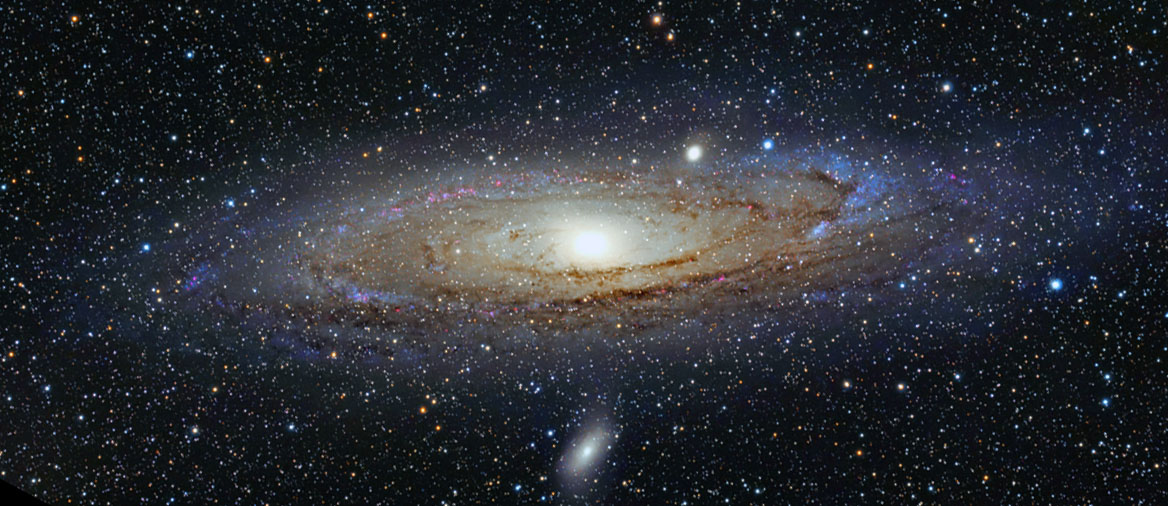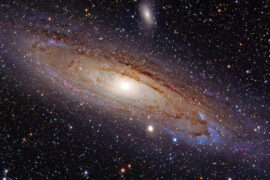The distances in the universe are really hard to wrap our heads around. For example, the closest star to our Solar system is Proxima Centauri. It is located 4.3 light-years away from us, or approximately 39.9 trillion kilometers (that’s twelve zeroes) or 25.3 trillion miles.
But as it turns out, all of the thousands of stars that we see in the night sky and even the millions that we see with our telescopes are a small group found within our own galaxy. Other galaxies are much farther away. Take, for example, the closest galaxy to us is the Canis Major Dwarf Galaxy which is 25,000 light-years away. That is almost 6,000 times farther away than Proxima Centauri.
Because of these large distances, galaxies are hard to observe. They are just too far away. There is a silver lining, though. Because galaxies are made up of millions or even billions of stars, they are extremely bright as a whole, making it possible for us to see them, even if usually a telescope is necessary to do so.
So that begs the question, can we see other galaxies with our eyes? that is, without the help of a telescope?
Before we answer that, there is something that we have to explain.
Apparent Magnitude explained
Astronomers use a metric called magnitude to measure the brightness – or more precisely, the luminosity – of an object in space.
There are two types of magnitude. First, there is absolute magnitude which is the measure of how bright an object is if you were to look at it from a standard distance away from it. The second one is the one we care about for this post, and that is apparent magnitude, which is the measure of how luminous an object is as seen from Earth.
The magnitude uses a logarithmic scale and goes from negative to positive numbers. A lower number indicates a brighter object. For example, the Sun has an apparent magnitude of -27, Venus has an average magnitude of -4, and Pluto has an apparent magnitude of +13.6.
Why is this important to our question? well, every optical device, including our eyes, has a maximum limiting magnitude that they are able to see. A basic home telescope has a limiting magnitude between 10 and 14 depending on how powerful it is and the conditions of the sky.
Our eyes, after dark adaptation, have a limiting magnitude between 6 and 7. That means that we can see in the sky any object with a lower magnitude than that assuming the sky is clear and there isn’t too much light pollution.
With that in mind, we can now answer the question.
Can we see other galaxies with our eyes?
Yes. The human eye can see from Earth galaxies that have a magnitude lower than 6. There are a few galaxies that meet this requirement, including the Andromeda galaxy and the Large and Small Magellanic Clouds.
The following table shows the list of galaxies that can be observed from Earth with the naked eye.
| Galaxy | Apparent magnitude | Distance (ly) | Constellation |
|---|---|---|---|
| Milky Way | -6.5 | 0 | N/A |
| Large Magellanic Cloud | 0.9 | 160,000 | Dorado |
| Small Magellanic Cloud | 2.7 | 200,000 | Tucana |
| Andromeda Galaxy | 3.4 | 2.5 million | Andromeda |
| Triangulum Galaxy | 5.7 | 2.9 million | Triangulum |
| Centaurus A | 6.8 | 13.7 million | Centaurus |
| Bode’s Galaxy | 6.9 | 12 million | Ursa Major |
| Sculptor Galaxy | 7.2 | 12 million | Sculptor |
The distance in the table above is given in light-years.
The constellation column indicates the general area of the sky where the galaxy can be observed. Remember that constellations are just a matter of perspective and are not really groups of stars or objects that are close to each other.
As for the Milky Way, that is the galaxy we are in. The part that can be observed from Earth is just one of the arms.
If you live in a large city, chances are you will only be able to see the Magellanic Clouds, and maybe the Andromeda Galaxy for a few weeks every year (November is generally the best time). Anything dimmer than that is probably going to be darkened by light pollution.
Even though we can observe these galaxies, it is very difficult to identify any individual objects within. For example, we have only been able to detect a couple of candidate planets in the Andromeda Galaxy even though it probably has millions of them. Even locating planets within our galaxy in stars like Proxima Centauri is quite hard.
Summary
- It is possible to see other galaxies with the human eye without the help of binoculars or a telescope
- Our eyes can see galaxies and stars with a magnitude lower than 7
- There are 6 or 7 other galaxies that can be observed from Earth with our eyes, the most prominent one is the Andromeda Galaxy







